Freedom Isn’t Weak: The Political and Artistic Significance of the Chinese ‘Socialist Core Values’ Graffiti and the Counter-Graffiti in East London
Freedom Isn’t Weak: The Political and Artistic Significance of the Chinese ‘Socialist Core Values’ Graffiti and the Counter-Graffiti in East London
Yao Bo, August 18, 2023
Yao Bo (姚博), better known as Wuyuesanren (五岳散人), was a well-known Chinese journalist, a Weibo “Big V” with a large number of followers until he was banned, and one of the 303 signers of Charter 08. In recent years he has been residing in Kyoto, Japan. He runs the popular @wuyuesanren YouTube channel commenting on current affairs in China. Below is a translation of his commentary on August 8, 2023. With his permission, the transcript has been edited for brevity. – The Editors
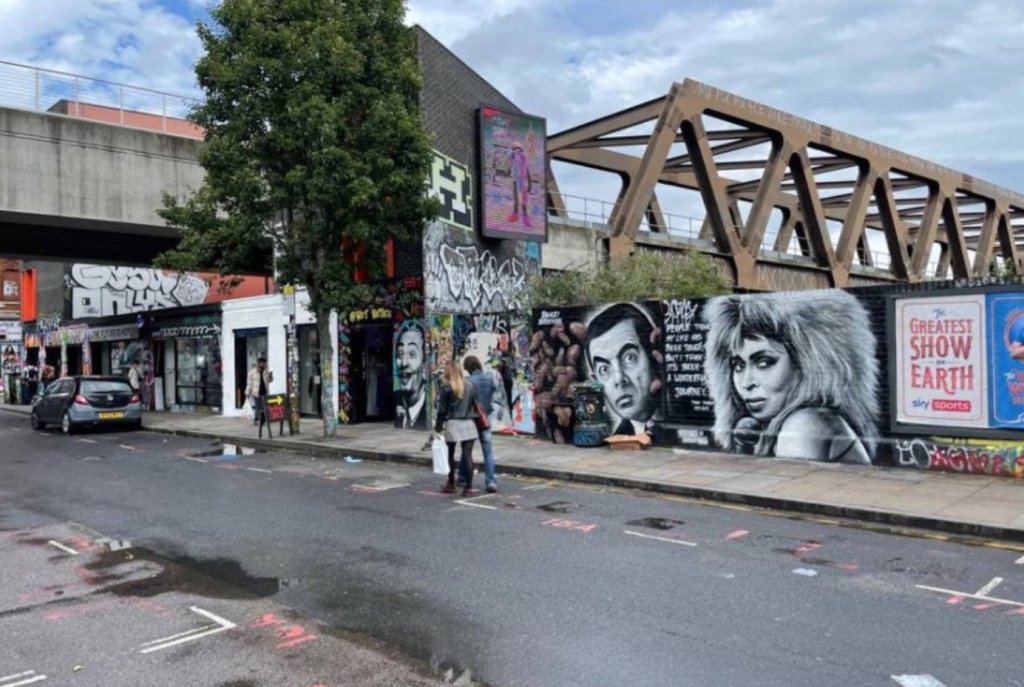
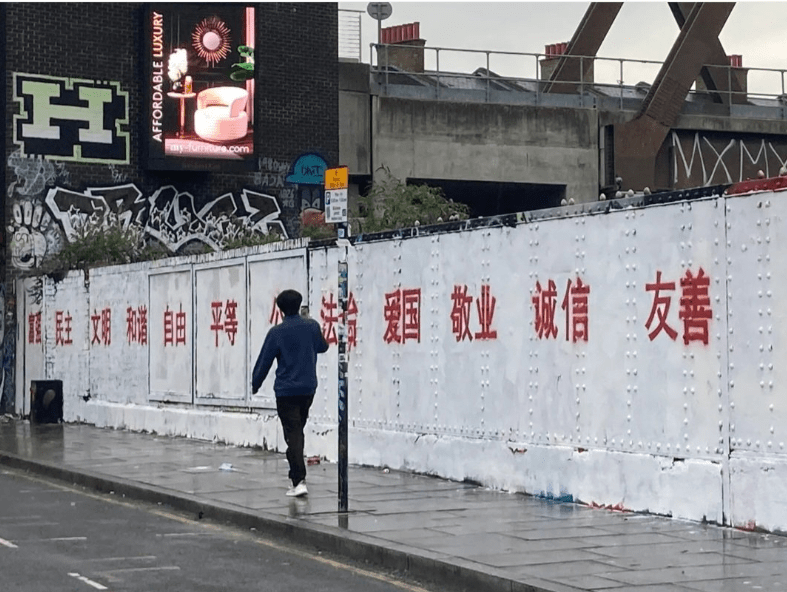
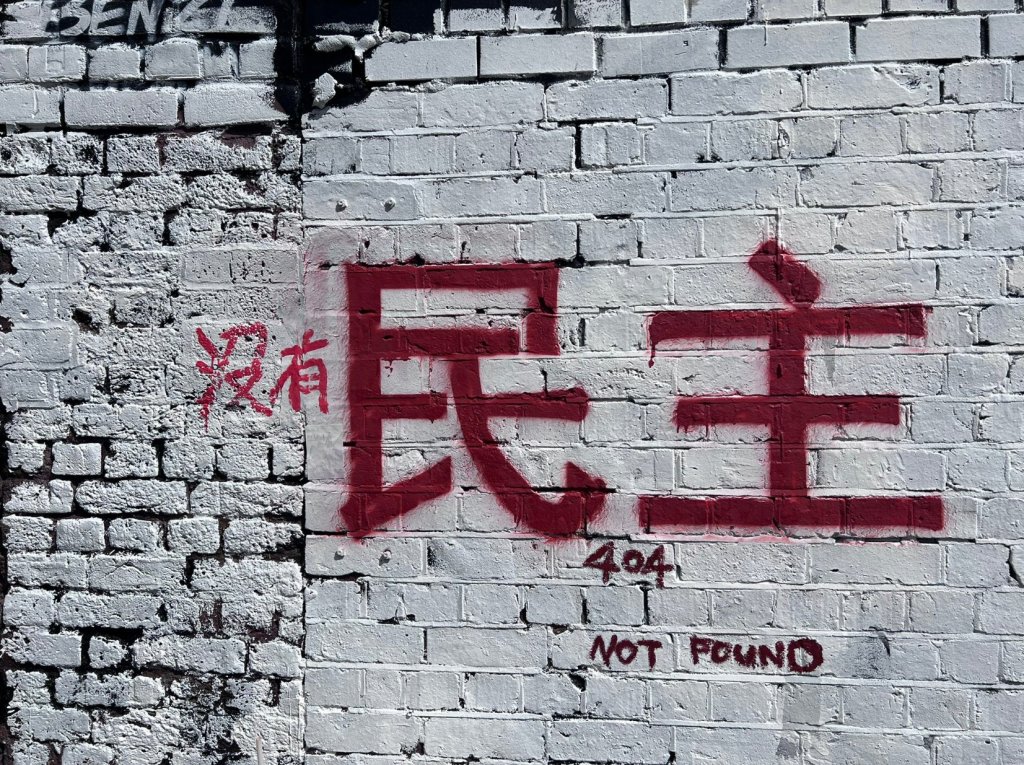
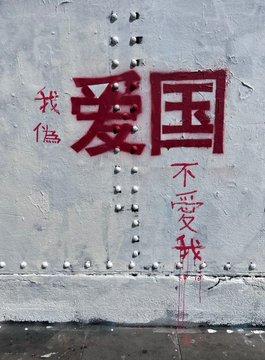

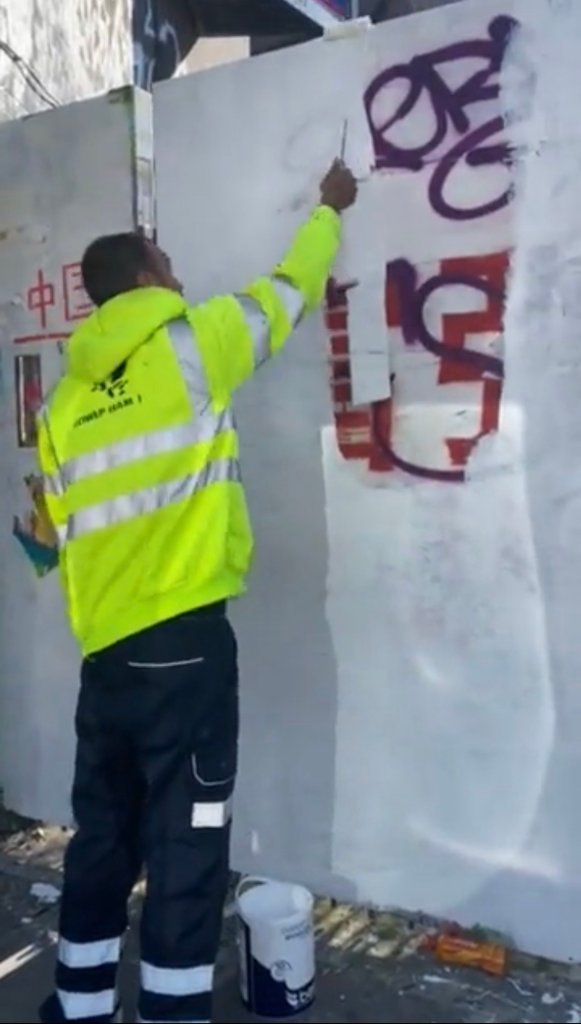
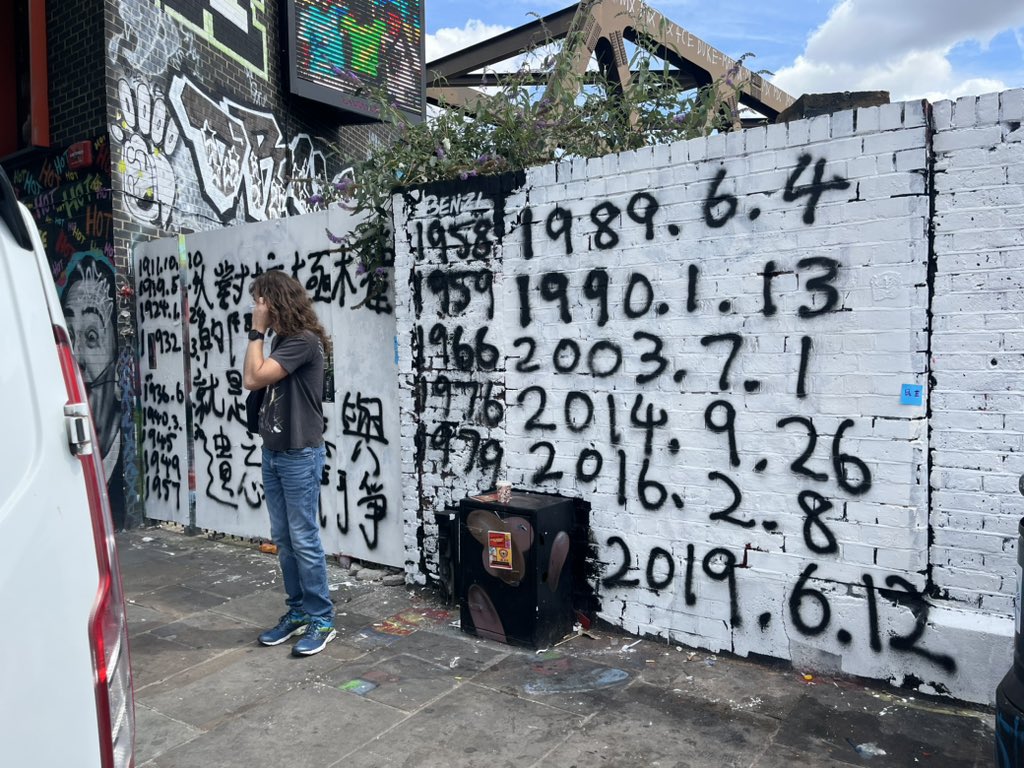
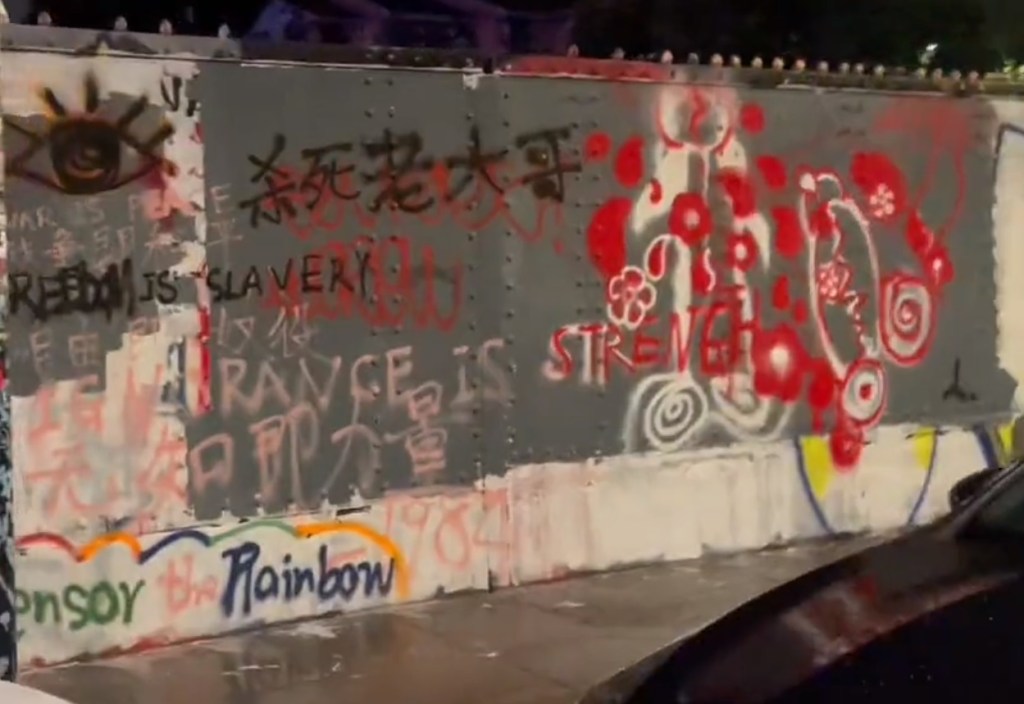

Photos: @whyyoutouzhele
Some netizens hoped that I could talk about the incident where someone painted the CCP’s “socialist core values” on a graffiti wall in East London. I’ve been following the incident since it happened. Let’s first review what has happened so far.
On August 5, one or more Chinese students from the Royal College of Art covered up the original works on the famous graffiti wall [Brick Lane] in East London with white paint and emblazoned upon it 24 deep-red boldface Chinese characters forming the “socialist core values” [prosperity, democracy, civility, harmony, freedom, equality, justice, the rule of law, patriotism, dedication, integrity and friendliness]. Then, beginning August 6, this location turned into a site for secondary additions to the graffiti.
Over the next two days, various individuals, [supposedly other Chinese students in the UK,] started adding counter-expressions to these 24 characters, and as of today, it’s not completely over. It’s possible this site may turn into a hub for expressing anti-China sentiment for a while. Since someone started this, why not just continue and use this as a base for “insulting China” (“辱华”), right? Treat it as a platform to let everyone vent their frustrations here – I find this quite amusing.
After two days, the London municipal workers covered both the original 24 characters and the subsequent additions, with white paint.
On August 7, the lead creator of this “socialist core values” graffiti, who goes by the name “Yi Que” (一鹊), released a statement claiming that he was the target of online harassment, and called upon it to stop. He emphasized that his act of painting these 24 characters didn’t carry any political stance. As of the time I’m recording this episode, this is the sequence of events that I’ve observed. Today, I’ll discuss the political and artistic significance of the events.
Honestly, one can’t help but be skeptical when the creator states that he has no political stance. To put it in a not-so-pretty analogy, when you have already spread your legs and started collecting money, you are no longer entitled to the claim of innocence. Something is amiss.
When the story first broke on August 5th, I actually found this young artist quite interesting. I didn’t think of him as a “little pink” (a term used to describe fervent Chinese nationalists and CCP supporters), because I thought his action was highly ironic, and symbolic too. Regardless of your taste, the original graffiti on that street had an artistic quality, but the Chinese students covered it all up with white paint and brushed on those 24 characters in the most unattractive, repulsive font.
However you do calligraphy, even if you consider it useless, there’s a distinction between what’s visually pleasing and what’s not. Besides being an expression, art should possess a certain decorative aspect. But the font of those 24 characters is a hybrid of totalitarian aesthetics and a certain coarseness.
All of China’s current propaganda and visual representation in particular, such as that painted on walls, are such a fusion. By covering the original graffiti with this hybrid onto that wall, it seems to say, “You see, if China’s system were to sweep across the world, it would cover up all the beautiful things.” Like how it has changed Hong Kong. Like how it destroyed China’s heritage, such as our ancient architecture, during the Cultural Revolution. If China’s current ideology were to spread and predominate around the world, the intricate and beautiful world as you know it would turn into a white wall with the most repulsive font painted in a blood-red color. This irony is incredibly explicit. So, when I first saw this, I didn’t think of the person as a “little pink” or anything like that; Instead, I felt that he had performed a very subtle and meaningful form of satire.
But when this artist started claiming he had no political stance, my perception changed. Firstly, everyone has a political stance; even if you don’t care about politics, politics cares about you. Secondly, you chose a political slogan, which is China’s so-called “socialist core values.” Each of these characters, each individual word, is a good word, and they’re used by all democratic nations around the world; each represents a positive value. But just like the joke goes: if you wear a T-shirt with all these 24 characters printed on it, you are good. However, if you separate them and create 12 different T-shirts, some might be fine, others are not. For example, if you have “patriotism” and “dedication” out of the 24 characters on the back of a T-shirt, it’s going to be fine. But if you make a T-shirt with “democracy” and “freedom” out of these 24 characters and wear it, you’re going to run into trouble.
In other words, these 24 characters together form a purely Chinese political expression known as “socialist core values,” in which each individual word cannot be separated from the whole. In essence, what is it? It’s a fig leaf with which the authoritarian state rule covers its face or its lower body. It is impossible for you to paint this political expression on a wall but claim you take no political stance in doing so.
Your political stance can only fall into two possibilities. The first one is that you lean towards the Chinese Communist Party (CCP), and you endorse the “socialist core values” and what is hidden behind this fig leaf. It’s how the devil looks after putting on makeup. Or, you’re engaging in true satire. But we all know one thing: if you’re engaging in satire, you would never claim you have no political stance, and you would tell the world what this act is all about: you’re trying to alert the free world that such things are blotting out the vibrant and colorful free society.
But as soon as you started pleading “don’t cyberbully my family,” you made it quite difficult for anyone to believe that you were engaging in a thought-provoking form of art to alert the world. That leaves one possibility only — you are a “little pink” and your act is explicitly political in meaning.
In London, which is the birthplace of capitalism, your action is meant to tell the free world: “I’ve infiltrated you. Since you’re all about freedom of speech, then you have to grant me this freedom too.”
I’ve been thinking that there is a price to pay for freedom. For example, the graffiti in East London being whitewashed by communist propaganda is a price a free society has to pay.
As a famous saying has it, freedom isn’t free. But freedom isn’t weak either. Many overseas pro-CCP patriots are overly confident that they can take advantage of the free society to do anything they want, namely, to undermine it, and there is nothing anyone can do about it. But freedom is not as vulnerable as they think. While a free society accepts the price of letting you speak, it can make you pay a price for what you do. In the case of the graffiti wall in East London, the art students’ act invited backlash from people with opposing opinions who quickly turned the site into a hub for criticizing China with their secondary creations. When you take advantage of a free and democratic society to challenge democracy and freedom, you will find out that such a society is neither stupid nor weak. Don’t do it. You will not be able to impose ugly totalitarian art over the vibrant and colorful free world. Such is the political significance of this incident, as I see it.
A work of art, as I said before, especially modern art, does not stop when the creator stops. Classic art, be it sculpture, oil painting, watercolor, acrylic painting, or traditional Chinese painting, may leave less space for interpretation. While some art forms are more inviting to such interaction than others, all works of art, as a matter of fact, undergo the process of creation, viewing, and reviewing to complete themselves. In literature, as people like to say, for a thousand readers, there are a thousand Hamlets; in music, the performer Yu Boya (俞伯牙) is completed by his best listener Zhong Ziqi (鐘子期).
The level of interactivity is undoubtedly stronger when it comes to modern art. More people are participating in the secondary additions to the 24-character “socialist core values” graffiti. Should it continue, that wall in East London might very well become a new landmark for graffiti art, a venue for the clash of two opposing political and social ideologies. It could go on and become a long process, and with every change people make on every frame, the art itself evolves towards completion.
So essentially, these “little pink” art students shot themselves in the foot and inadvertently opened up a stage for others. I believe this is something he didn’t expect when he executed his plans. Now the London municipal authorities have painted the wall back to its original white, but if people continue using it to express their criticism of the Chinese government and human rights abuses in China, what will it turn into eventually? My friend Ms. Shi Jinxia (史金霞) has a name for it: the “Crying Wall” (“哭牆”).
The whole thing will be fascinating if from now on it indeed turns into a wall of criticism against China.
Were these two art students to return to China and try to ingratiate themselves with the authorities for their 24-character graffiti, I’m sure the propaganda officials — assuming they have any intelligence or any understanding of modern art — would want to strangle them to death.
Also by Yao Bo:
‘Not a Single Penny’: Why One Overseas Chinese Won’t Donate to ‘Disaster Relief’ Efforts in China, Wuyuesanren, August 5, 2023.





Comments are closed.